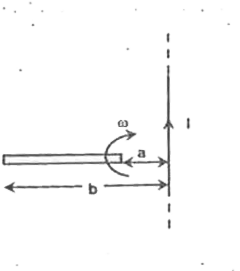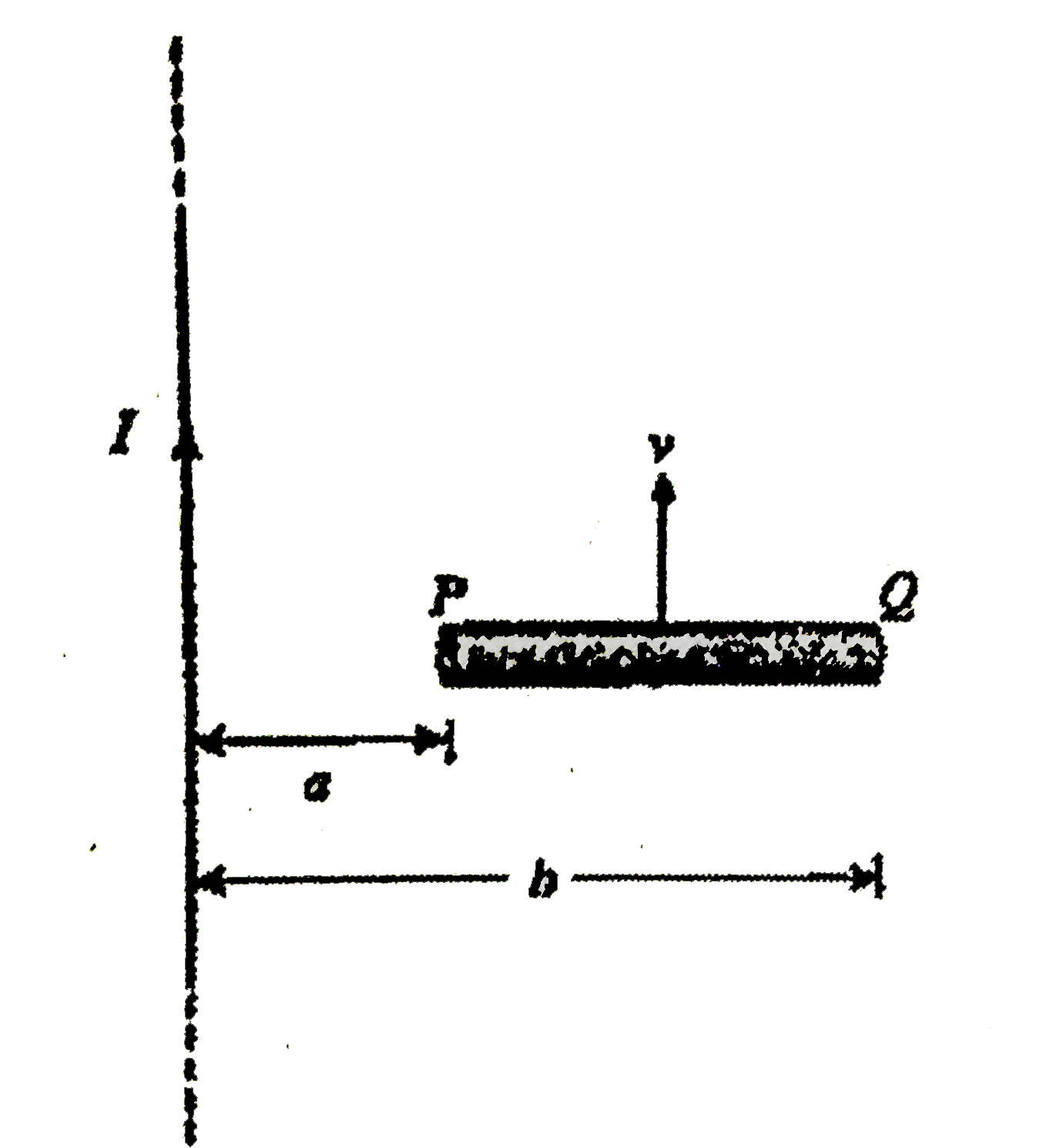A copper of length 0.19 m is moving with uniform velocity 10/ms parallel to a long straight wire carrying current of 5.0 ampere. The rod itself is perpendicular to the wire its ends at distance 0.01 m and 0.2 m from it. Calculate the emf induced in the rod.
As shown in figure (a) consider an element of length dy at a distance y from the wire, then at this position of the element, the field due to the cuurent - carrying wire PQ will be

B=μ04π2Iy into the page.
So the emf induced in the element
de = Bv dy=μ04π2Iy v dy
and hence the emf induced across the ends of the rod due to its motion in the field of the wire,
e=∫bade=μ04π2Iv∫badyy
i.e., e=μ04π2Iv loge(ba)
Subsitituting the given data with b=(a+l),
e=10−7×2×5×10 loge0.200.01=10−5×loge20
So, e=10−5×2.3026×1.3010≅30μV
Similar Questions
A copper rod of length 0.19m is moving with uniform velocity 10ms−1 parallel to a long straight wire carrying a current of 5.0A. The rod is perpendicular to the wire with its ends at distances 0.01 and 0.2m from it. Calculate the emf induced in the rod.
View SolutionA copper rod of length 0.19m is moving with uniform velocity 10ms−1 parallel to a long straight wire carrying a current of 5.0A. The rod is perpendicular to the wire with its ends at distances 0.01 and 0.2m from it. Calculate the emf induced in the rod.
View Solution
Knowledge Check
- Question 1 - Select One
A uniform metal rod is moving with a uniform velocity v parallel to a long straight wire carrying a current I. The rod is perpendicular to the wire with its ends at distance r1andr2 (with r2>r1) form it. The E.M.F. induced in the rod at that instant is
AzeroBμ0Iv2πln(r2r1)Cμ0Iv2πln(r1r2)Dμ0Iv4π(1−r1r2) - Question 2 - Select One
A copper rod moves with a constant angular velocity ω about a long straight wire carrying a current I. If the ends of the rod from the wire are at distances a and b, then the e.m.f induced in the rod is
 Aμ0i(wa)2πIn(ba)Bμ0i(wb)2πIn(ba)CzeroDμ0iw(a+b)4πIn(ba)
Aμ0i(wa)2πIn(ba)Bμ0i(wb)2πIn(ba)CzeroDμ0iw(a+b)4πIn(ba) - Question 3 - Select One
A long straight wire carries a current of 10 A. An electron travels perpendicular to the plane of this wire at a distance 0.1 m with a velocity of 5.0×106m/s. What is the force acting on the electron due to the current in wire ?
A2.2×10−17NB1.6×10−17NC0.6×10−17NDZero
A copper rod of length L is moving at a uniform speed v parallel to along straight wire carrying a current of I as shown in figure-5.25. The rod is perpendicular to the wire with its ends at distance a and b from if . Calculate the motional EMF induced in the rod.
 View Solution
View SolutionA uniform metal rod is moving with a uniform velocity v parallel to a long straight wire carrying a current I. The rod is perpendicular to the wire with its ends at distance r1andr2 (with r2>r1) form it. The E.M.F. induced in the rod at that instant is
View SolutionA conducting rod length 1m moves with a speed of 2m/s parallel to a straight long wire carrying 4A current. Axis of rod is kept perpendicular to the wire with its near end at a distance of 1m from the wire. Magnitude of induced emf in rod is N×10−7log16volt. Find the value of N.
View SolutionA copper rod moves with a constant angular velocity ω about a long straight wire carrying a current I. If the ends of the rod from the wire are at distances a and b, then the e.m.f induced in the rod is
 View Solution
View SolutionThe figure shows a copper rod moving with velocity v parallel to a long straight wire carrying a current I = 100 A. Calculate the induced emf in the rod, assuming that v = 5 m/s, a = 1 cm and b = 100 cm.
View Solution


